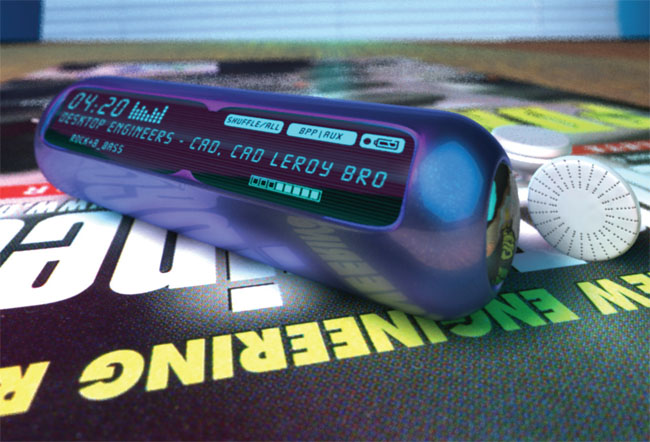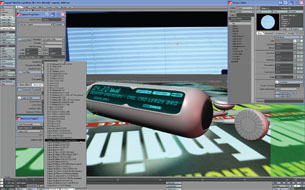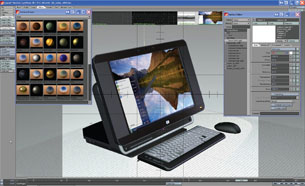Latest News
October 1, 2009
By Mark Clarkson
LightWave is in the class of “art and media” applications that includes 3ds Max and Maya. Like those programs, it is used heavily in the production of games, motion pictures, television, and print ads. Unlike those programs, LightWave is one of the few remaining major players in non-CAD 3D space not owned by the Autodesk juggernaut.
 A prototype MP3 player rendered with LightWave’s new Car Paint shader, and Sigma fisheye lens. |
LightWave isn’t a CAD program. There is no real 2D component, no BOM and no construction history. An engineer will probably find LightWave most useful for creating beautiful renders and animations of designs created in other applications, or as a less structured environment for “sketching” out initial designs.
Two Apps in One
LightWave is really two separate applications: Modeler for modeling, and Layout for rendering and animation. It’s not nearly as bad as it sounds, though; the two applications are tied together. It’s functionally similar to the way most CAD programs let you pop in and out of different environments for models, drawings, and assemblies. You can select an object in Layout, press a key, and open that object up in Modeler. Likewise, changes made in Modeler are automatically reflected in Layout. LightWave Hub, a mini-application, sits in your task bar and facilitates the interaction.
I’ve actually come to prefer it over the everything-all-the-time approach of similar applications; editing individual objects within the context of a complex scene can become quite cumbersome.
 LightWave’s Layout application is where you render and animate your creations. |
Modeler
LightWave is a polygon and surface modeler. All objects, by default, are polygon meshes. You create objects from primitives (i.e., cubes or spheres), by extruding or lofting curves along paths, or by linking 2D curves together to define curved 3D surfaces.
For organic surfaces, turning a poly mesh into a curved subdivision surface (SDS) is as easy as hitting the Tab key. The mesh becomes a cage on which the curved surface is hung; you modify the surface geometry by manipulating the components—polygons, edges, points—of the underlying cage. Another touch of the Tab key converts the object back to polygon mode.
You can model in polygons, SDSs, or a combination. You can freeze curve surfaces as polygonal meshes, or retain them as is for rendering and animation.
Modeler provides ten layers, accessed by the number keys. Different layers can hold curves, construction surfaces, models or parts of models. I often use layers as an easy way to keep iterative versions of my objects. LightWave’s layer functionality is limited, but it’s super fast and easy to pop back and forth the between layers, combine layers, place different layers in the foreground or background, and so on.
In fact, LightWave’s Modeler is fast and easy to use, in general.
Rendering Texturing
LightWave’s rendering has always been top-notch, and continues to get better. In 9.6, global illumination calculations are much faster, and rendering feedback is greatly improved.
LightWave’s texturing has taken a big leap forward with the addition of nodal shading. You can build up fantastically complex texture networks using nodes for 2D and 3D textures, gradients, math functions, and materials. One heralded example is the new Carpaint shader that realistically simulates auto paint, complete with clear coat and metal flake.
 LightWave allows you to easily select for a wide range of real-world cameras and lenses. |
You can also build nodal networks to control volumetric lighting and object displacement maps.
Lights, Camera
To help you better match reality, LightWave now has IES (Illuminating Engineering Society) profile lights and a greatly expanded selection of cameras, including perspective, orthographic, shift, and real-world cameras, as well as a configurable advanced camera.
You can create virtually any imaginable camera/lens combination. You want to replicate a Canon SLR with a Sigma 15mm f/2.8 fisheye lens? No problem; the real-world camera has those options. Want to create a custom tilt-shift lens? You can do that too. This is a big help to users trying to match camera/lens combinations when, for example, compositing a render into an existing scene.
Unfortunately, the layout window doesn’t always accurately reflect the appearance of the final render; the distortion of fish eye lenses, for example, doesn’t show up. This makes camera setup a bit difficult.
Quibbles
One barrier to integrating LightWave into the engineering pipeline is its somewhat limited import and export capabilities. It hasn’t got nearly the range of, say, Rhino. You won’t find STL or IGES; OBJ and 3DS are your best bets. LightWave 9.6 has added support for the increasingly popular open standard COLLADA format. LightWave is one of the few programs still shipping with printed manuals, but it also has Web-based help. Sadly, there are holes.
Take Visor for example—a new image-viewing feature within Layout. I only know about it because I stumbled upon a discussion on the Web. I couldn’t find it in a menu or on a button. It doesn’t appear in the printed manual, and searching for it in the online help gets you no results. The feature doesn’t seem to come pre-installed, either. You have to know it exists, know its name, manually add the plug-in to LightWave, and then manually add it to a menu somewhere. That’s a lot of work for a new feature.
LightWave isn’t alone in having surprising omissions in its help; I seem to ding every application I review for the same thing. C’mon, guys!
In Summation
Quibbles aside, LightWave has a lot going for it. It is one of the most widely used 3D modeling and rendering solutions, and for good reason. It is comparatively easy to learn and use, filled with great features, and capable of motion-picture quality photo-real renders and animations.
LightWave goes way beyond static renders and simple turntable animations. It will do complex character animation; grow fibers, fur and hair; and render dynamics such as sparks, smoke, explosions, and fairy dust blowing in the wind.
And, with an MSRP of $895, LightWave represents an astounding value.
More Info:
NewTek
Contributing Editor Mark Clarkson, a.k.a. The Wichita By-Lineman, has been writing about all manner of computer stuff for years. An expert in computer animation and graphics, his newest book is Photoshop Elements by Example. Visit him on the web at markclarkson.com or send e-mail about this article c/o [email protected].
Subscribe to our FREE magazine, FREE email newsletters or both!
Latest News
About the Author
Mark ClarksonContributing Editor Mark Clarkson is Digital Engineering’s expert in visualization, computer animation, and graphics. His newest book is Photoshop Elements by Example. Visit him on the web at MarkClarkson.com or send e-mail about this article to [email protected].
Follow DE





